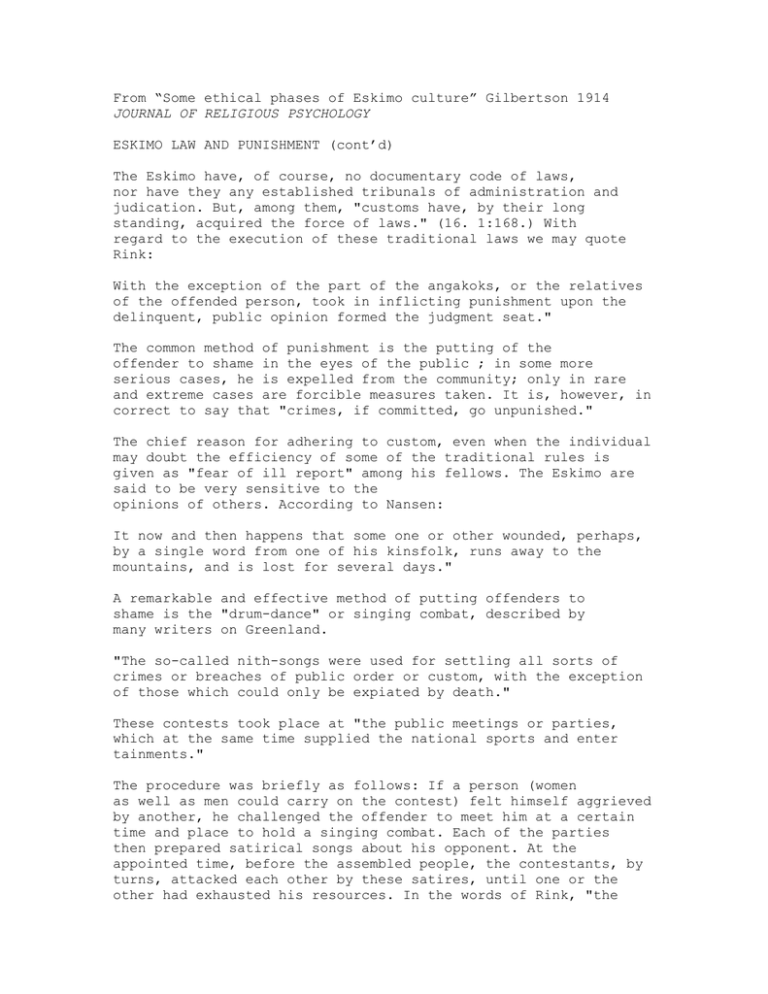From “Some ethical phases of Eskimo culture” Gilbertson 1914
advertisement

From “Some ethical phases of Eskimo culture” Gilbertson 1914 JOURNAL OF RELIGIOUS PSYCHOLOGY ESKIMO LAW AND PUNISHMENT (cont’d) The Eskimo have, of course, no documentary code of laws, nor have they any established tribunals of administration and judication. But, among them, "customs have, by their long standing, acquired the force of laws." (16. 1:168.) With regard to the execution of these traditional laws we may quote Rink: With the exception of the part of the angakoks, or the relatives of the offended person, took in inflicting punishment upon the delinquent, public opinion formed the judgment seat." The common method of punishment is the putting of the offender to shame in the eyes of the public ; in some more serious cases, he is expelled from the community; only in rare and extreme cases are forcible measures taken. It is, however, in correct to say that "crimes, if committed, go unpunished." The chief reason for adhering to custom, even when the individual may doubt the efficiency of some of the traditional rules is given as "fear of ill report" among his fellows. The Eskimo are said to be very sensitive to the opinions of others. According to Nansen: It now and then happens that some one or other wounded, perhaps, by a single word from one of his kinsfolk, runs away to the mountains, and is lost for several days." A remarkable and effective method of putting offenders to shame is the "drum-dance" or singing combat, described by many writers on Greenland. "The so-called nith-songs were used for settling all sorts of crimes or breaches of public order or custom, with the exception of those which could only be expiated by death." These contests took place at "the public meetings or parties, which at the same time supplied the national sports and enter tainments." The procedure was briefly as follows: If a person (women as well as men could carry on the contest) felt himself aggrieved by another, he challenged the offender to meet him at a certain time and place to hold a singing combat. Each of the parties then prepared satirical songs about his opponent. At the appointed time, before the assembled people, the contestants, by turns, attacked each other by these satires, until one or the other had exhausted his resources. In the words of Rink, "the cheering or dissent of the assembly at once represented the judg ment as well as the punishment." It appears that, in East Greenland at least, the issue is not always decided by one performance, but the contest is repeated, so that it can stretch over many years. On the value of this judicial system, it is interesting to note the verdict of the Moravian Crantz: It is an excellent opportunity of putting immorality to the blush, and cherishing virtuous principles. Nothing so effectually restrains a Greenlander from vice as the dread of public disgrace, and this pleasant way of revenge even prevents many from wreaking their malice in acts of violence or bloodshed. Here they cite each other to appear without risking their lives in the duel, or wounding each other with envenomed pen. In an East Greenland tale, the parties in a bloodrevenge agree not to kill each other, but settle the matter with a drum-dance. While, in the contest, they are at liberty to lampoon each other to their hearts content, as soon as the performance is over they must not let it appear that there has been any trouble between them. Also before and during the contests no bitter feeling must be manifested. It happens that one plays the part of host to his opponent. An appearance of perfect calm should be maintained by the one under fire. One "made his indifference known by calling on the spectators to shout and amuse themselves over him." The word "nith-song" is of Norse derivation. Tylor was of the opinion that the institution itself had been introduced into Greenland by the Norwegian colonists. Its native origin is now generally accepted. A drastic measure for maintaining order and punishing delinquency, and one very rarely employed, is expulsion. Typical is the case of a young man who was turned out of the house in the middle of winter. Rink says, "As to the possibility of maintaining the authority of law, it must be remembered that the members in these isolated communities are more immediately dependent on their fellowmen than the members of a civilized society, and that what is considered at the most a trifling inconvenience in the latter, may be a severe punishment in the former", and we must agree with him that few punishments could be more severe than "being suddenly abandoned without shelter in the depths of an Arctic winter ; between this and the disagreeableness of being shamed by a song in an assembly, several degrees of punishment may be imagined sufficient to deter malicious individuals from ordinary offences or disturbances of order and peace." Crimes involving punishment by death, of which practically the only ones are murder and witchcraft (which latter, accord ing to Eskimo belief, may cause death) are dealt with in one of two ways; usually by blood-revenge on the part of the kindred of the victim, or, in a few cases, by the concerted action of the whole community. Blood-revenge is considered a duty, as well as a right, among all Eskimo. It is one phase of their conception of justice. What Kropotkin says of the Dayak "head-hunter" may be said also of the Eskimo. The avenger is not actuated by personal passion. . . . He acts under what he considers as a moral obligation, just as the European judge who, in obedience to the same principle of blood for blood, hands over the condemned murderer to the hangman." There is a belief that the soul of the murdered person does not get rest till he is avenged. The proper agent of revenge is the nearest male relative of the victim, although other relatives and even place-fellows may join. The primary object of the revenge is the death of the murderer himself. It is said to be usual for the avenger to explain to the murderer the reason for his taking-off. But, especially if the slayer cannot be apprehended, some of his relatives are also liable to be put to death. There appears to be a definite idea of personal responsibility, although with that goes communal liability also. Rink classes revenge carried out on some kindred or place-fellow as "neither decidedly admissive nor altogether unlawful." If a murdered man leaves an infant son, the latter is obliged to avenge his father s death as soon as he arrives at puberty. This is a frequent theme in folk-lore. The boy s training has this as its chief end. Now thou hast seen thy father killed, it will not do for thee to grow up in idleness," is a grandfather’s admonition. At the conclusion of a tale of this type, Rink gives us what he calls the "very characteristic remark" of the native narrator: "It is generally supposed that if his foster-father had not continually excited him [to revenge the murder of his parents], he would scarcely have grown to be so immensely strong." Boas tells us of a strange method of executing the bloodrevenge among the central Eskimo. Strange as it may seem, a murderer will come to visit the relatives of his victim (though he knows that they are allowed to kill him in revenge) and will settle with them. He is kindly welcomed and some times lives quietly for weeks and months. Then he is suddenly challenged to a wrestling match, and if defeated, is killed, or if victorious he may kill one of the opposite party, or when hunting he is suddenly attacked by his companions and slain. Often the blood-feud consists of a long series of retaliations, the first revenge calling forth another, and so on. It may even be handed down to successive generations. Rink is of the opinion that continued blood-revenge is less decidedly admissible than the first retaliation. Such a feud may be concluded by mutual agreement. In a Greenland tale, a man planning revenge was advised by an old bachelor, Thou hadst better give it up and leave thy father alone. He was only paid back according to his deserts, being himself a man-slayer. And the son replied, "Let it be as thou proposes, perhaps I shall only get new foes if I carry out my thoughts of vengeance, and so the parties were reconciled. Capital punishment, as the result of deliberation by the community, was inflicted on witches, and persons regarded as dangerous to public welfare. According to Nansen, "in cases of extreme atrocity, the men of the village have been known to make common cause against a murderer, and kill him." A very interesting procedure is described by Boas, "If a man has committed a murder or made himself odious by other outrages he may be killed by anyone simply as a matter of justice. The man who intends to take revenge on him must ask his countrymen singly if each agrees in the opinion that the offender is a bad man deserving death. If all answer in the affirmative he may kill the man thus condemned and no one is allowed to revenge the murder." As stated before, the Eskimo believe that people may be killed by witchcraft, so that witches would be only a special class of homicides. A missionary was explaining how God punishes wicked people, when an Eskimo remarked that "in that respect he was like God, for he had killed three women who were witches."





